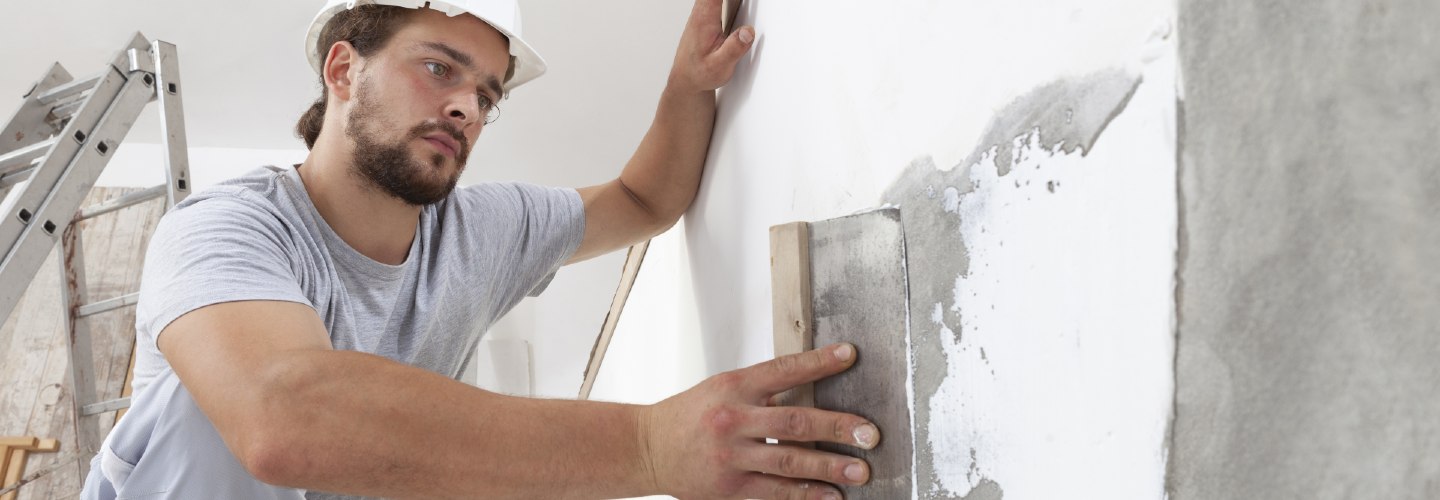

Find a professional plaster repair service near you
Fill in a short form and get free quotes for plaster repair services
Need a plaster repair contractor?
- Plaster refinishing
- Pool plaster repair
- Plaster crack repair
- Plaster hole repair
- … or anything else
What is Airtasker?

Post your task
Tell us what you need, it's FREE to post.

Review offers
Get offers from trusted Taskers and view profiles.

Get it done
Choose the right person for your task and get it done.
Why book a plaster repair service through Airtasker?
Did the old plaster on your wall or ceiling crack? Maybe your plaster got punctured by accident as you were moving furniture? Whatever caused the damage, Airtasker can find you the right Tasker to fix it! We can match you with some of the most experienced and skilled plaster repair specialists in your area - even at short notice!
All it takes is to make a post with all the crucial details. Mention the type of plaster damage it is, whether it’s on your walls or ceilings, your location, and your budget. Qualified Taskers will ask you about the damage with a free quote. You can get dozens of inquiries within minutes, so don’t be surprised and try not to settle on the first offer.
Check each Tasker’s ratings and reviews to pick the right one, so you don’t hire a Tasker based on their rates alone. Tap twice on the button to confirm your choice, then set an appointment to discuss the job in further detail. Use the “Post a task” button and get the plaster repair you need now!
Quick offers
Don’t put off getting your damaged wall fixed. Get quotes from plaster repair experts in your area and sort your repairs out this week.
Choose your budget
Hire the best plaster repairer you can afford and get incredible value for money.
Stay insured
Get the best taskers
Top Plaster Repair related questions
This can take as little as a few hours to at most a couple of weeks. The time it will take can depend on the severity of the damage and the complexity of the repairs. In some cases, temperature and humidity are also factors as these can affect how fast each layer of filler, adhesive or new plaster dries. You can ask your Tasker for an estimate of how long it may take to do these repairs.
Only if you have a good reason to do so, such as if it’s coming off in large pieces, it’s not advisable to remove old plaster. Old plaster in your home is often of a higher quality than most other materials (like drywall), and you can lose its soundproofing and mould-inhibiting benefits. This is also laborious and time-consuming, and therefore costly, so you may want to hire an expert to repair and restore your plaster instead.
It sure can! Old plaster that’s restored can increase your home’s historical authenticity. If yours is a Victorian-era home, don’t remove any of the plaster - this is very sturdy, buyers expect it to have it, and you may get a higher appraisal than other homes on the market. Should you build a new home, try using as much plaster as possible to make it more durable, require less maintenance and make your home more valuable.
Efflorescence is the appearance of white crystalline material after the plaster has dried. This is caused by soluble salts present within the wall or ceiling or present in the water, lime, sand or other material used to make the plaster. This can be unsightly and make it difficult (if not impossible) for any paint to stick to the surface. You can remedy this by washing and dry-brushing the surface until no more crystalline material appears.
Yes, absolutely. Just remember that you can’t paint plaster that has only recently been repaired and dried right away. New plaster can be dry to the touch after about 1 to 2 days, but it may not be completely dry deep down! As plaster absorbs moisture, it can make a fresh coat of paint peel off after it’s dry. To be sure, let the plaster dry for about 4 to 6 weeks, then apply and smooth the primer or paint.
Most cracks on plaster are due to age. Over the years, plaster can separate from its lath and show up as cracks on the surface - this is cosmetic damage and can be fixed. But if plaster cracks are diagonal or jagged and measure more than 6 millimetres in width, this can be a sign of a more severe problem. These can be signs of a shifted foundation or deteriorated or collapsed wood beams due to termites; you may hire pest control to inspect.
Plasterer Services
What does a plaster repair service include?
Plaster repair services include everything needed to get your wall looking brand new again, whether it’s patching up a hole, covering a scratch, or replacing a section of the plaster. Your plaster repairer will bring their own supplies with them to complete the repair and clean up after themselves when they’re done. Here are some of the most common plaster repairs:
Hole repairs
Plasterboard and gyprock hole repairs are among the most commonly requested plaster fixes. First, your plaster repair expert will need to prepare the damaged area to be repaired. They’ll lay down a plastic sheet on the ground to protect the flooring below before inspecting the damage. If there’s any loose or crumbling plaster, they’ll use a utility knife to scrape it away. They’ll always check for any hidden cables and pipes in your wall before making any cuts if they need to. Your repair person will then use an adhesive mesh patch to cover up the wall, allowing a couple of centimetres overhang on either side. Next, they’ll apply a quick-setting filler, using a putty knife to push it through the mesh and cover up any gaps. They’ll smooth this over before leaving it to dry. Then they’ll sand the area smooth. Your repairer may repeat this process and add an extra layer of putty if needed.
Plaster crack repairs
Small holes, dents, and cracks in plaster can be repaired using plaster filler to close up any gaps. Your repairer will wait for this to dry before applying a topcoat of compound. Once dry, they’ll blend this with the surrounding wall using sandpaper. It’ll be ready to paint around 24 hours later.
Cornice repairs
Cornice repairs can be a complex process, depending on whether you have simple, curved cornices or complex, ornate cornices. If it’s a straightforward repair to fix a crack or hole, your repair person may simply use plaster filler and smooth this into the surface using a putty knife before sanding. However, ornate cornices can require more work to ensure the shape or pattern is maintained in the repair. This will often involve using a chisel to carefully shape the repair work. Alternatively, your cornices may have just lifted away from the ceiling or wall. In that case, your repair person may be able to patch up the gap using filler.